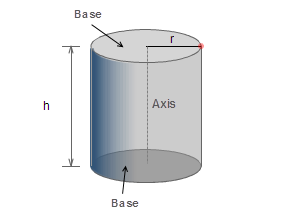
The number of corners in a cylinder is
(a) 1
(b) 2
(c) 3
(d) None
Answer
505.2k+ views
Hint: In this question, imagine a cold drink cane in your mind or take a battery in your hand and count the number of corners in these objects. The number you will get would be the number of corners a cylinder has because all these objects are of cylindrical shape.
Complete step-by-step answer:
Before proceeding with this question, let us see what cylinder is. In geometry, a cylinder is a closed solid that has two parallel (usually circular) bases connected by a curved surface. A cylinder is a geometric solid that is very common in everyday life, such as a cold drink cane, battery etc. If we take it apart we find it has two ends, called bases which are usually circular. The bases are always congruent and parallel to each other. If we were to 'unroll' the cylinder we would find that the side is actually a rectangle when flattened out.

Volume of a cylinder \[=\pi {{r}^{2}}h\]
Surface area of a cylinder \[=2\pi r(r+h)\]
Where the radius of the base of the cylinder is r and the height of the cylinder is h.
From the figure we can see that a cylinder has two parallel bases and a curved surface.
In this question we were asked about the number of corners in a cylinder. So now we have clearly seen that there is no corner in a cylinder.
Hence option (d) is the correct answer.
Note: Here we have to imagine real life objects like battery, cans etc. similar to a cylinder to get an idea. We can in a hurry think it has corners but we have to understand that it has circular bases joined by curved surfaces and the circle does not have corners.
Complete step-by-step answer:
Before proceeding with this question, let us see what cylinder is. In geometry, a cylinder is a closed solid that has two parallel (usually circular) bases connected by a curved surface. A cylinder is a geometric solid that is very common in everyday life, such as a cold drink cane, battery etc. If we take it apart we find it has two ends, called bases which are usually circular. The bases are always congruent and parallel to each other. If we were to 'unroll' the cylinder we would find that the side is actually a rectangle when flattened out.

Volume of a cylinder \[=\pi {{r}^{2}}h\]
Surface area of a cylinder \[=2\pi r(r+h)\]
Where the radius of the base of the cylinder is r and the height of the cylinder is h.
From the figure we can see that a cylinder has two parallel bases and a curved surface.
In this question we were asked about the number of corners in a cylinder. So now we have clearly seen that there is no corner in a cylinder.
Hence option (d) is the correct answer.
Note: Here we have to imagine real life objects like battery, cans etc. similar to a cylinder to get an idea. We can in a hurry think it has corners but we have to understand that it has circular bases joined by curved surfaces and the circle does not have corners.
Recently Updated Pages
Master Class 11 Economics: Engaging Questions & Answers for Success

Master Class 11 Business Studies: Engaging Questions & Answers for Success

Master Class 11 Accountancy: Engaging Questions & Answers for Success

Master Class 12 Economics: Engaging Questions & Answers for Success

Master Class 12 Maths: Engaging Questions & Answers for Success

Master Class 12 Biology: Engaging Questions & Answers for Success

Trending doubts
Fill the blanks with the suitable prepositions 1 The class 9 english CBSE

How do you graph the function fx 4x class 9 maths CBSE

Difference Between Plant Cell and Animal Cell

What is pollution? How many types of pollution? Define it

What is the color of ferrous sulphate crystals? How does this color change after heating? Name the products formed on strongly heating ferrous sulphate crystals. What type of chemical reaction occurs in this type of change.

Which places in India experience sunrise first and class 9 social science CBSE




